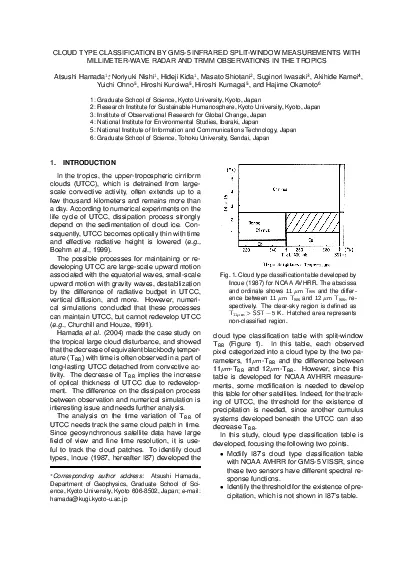

CorrespondingauthoraddressAtsushiHamadaDepartmentofGeophysicsGraduateSchoolofScienceKyotoUniversityKyoto6068502JapanemailhamadakugikyotouacjpFig1CloudtypeclassicationtabledevelopedbyInoue1987forNO ID: 863356
Download Pdf The PPT/PDF document "CLOUDTYPECLASSIFICATIONBYGMS5INFRAREDSPL..." is the property of its rightful owner. Permission is granted to download and print the materials on this web site for personal, non-commercial use only, and to display it on your personal computer provided you do not modify the materials and that you retain all copyright notices contained in the materials. By downloading content from our website, you accept the terms of this agreement.
1 CLOUDTYPECLASSIFICATIONBYGMS-5INFRAREDSP
CLOUDTYPECLASSIFICATIONBYGMS-5INFRAREDSPLIT-WINDOWMEASUREMENTSWITHMILLIMETER-WAVERADARANDTRMMOBSERVATIONSINTHETROPICSAtsushiHamada,NoriyukiNishi,HidejiKida,MasatoShiotani,SuginoriIwasaki,AkihideKameiYuichiOhno,HiroshiKuroiwa,HiroshiKumagai,andHajimeOkamoto1:GraduateSchoolofScience,KyotoUniversity,Kyoto,Japan2:ResearchInstituteforSustainableHumanosphere,KyotoUniversity,Kyoto,Japan3:InstituteofObservationalResearchforGlobalChange,Japan4:NationalInstituteforEnvironmentalStudies,Ibaraki,Japan5:NationalInstituteofInformationandCommunicationsTechnology,Japan6:GraduateSchoolofScience,TohokuUniversity,Sendai,Japan1.INTRODUCTIONInthetropics,theupper-troposphericcirriformclouds(UTCC),whichisdetrainedfromlarge-scaleconvectiveactivity,oftenextendsuptoafewthousandkilometersandremainsmorethanaday.AccordingtonumericalexperimentsonthelifecycleofUTCC,dissipationprocessstronglydependonthesedimentationofcloudice.Con-sequently,UTCCbecomesopticallythinwithtimeandeffectiveradiativeheightislowered(e.g.,etal.,1999).Thepossibleprocessesformaintainingorre-developingUTCCarelarge-scaleupwardmotionassociatedwiththeequatorialwaves,small-scaleupwardmotionwithgravitywaves,destabilizationbythedifferenceofradiativebudgetinUTCC,verticaldiffusion,andmore.However,numeri-calsimulationsconcludedthattheseprocessescanmaintainUTCC,butcannotredevelopUTCCe.g.,ChurchillandHouze,1991).etal.(2004)madethecasestudyonthetropicallargeclouddisturbance,andshowedthatthedecreaseofequivalentblackbodytemper-ature()withtimeisoftenobservedinapartoflong-lastingUTCCdetachedfromconvectiveac-tivity.ThedecreaseofimpliestheincreaseofopticalthicknessofUTCCduetoredevelop-ment.Thedifferenceonthedissipationprocessbetweenobservationandnumericalsimulationisinterestingissueandneedsfurtheranalysis.TheanalysisonthetimevariationofUTCCneedstrackthesamecloudpatchintime.SincegeosynchronoussatellitedatahavelargeÞeldofviewandÞnetimeresolution,itisuse-fultotrackthecloudpatches.Toidentifycloudtypes,Inoue(1987,hereafterI87)developedthe Correspondingauthoraddress:AtsushiHamada,DepartmentofGeophysics,GraduateSchoolofSci-ence,KyotoUniversity,Kyoto606-8502,Japan;e-mail:hamada@kugi.kyoto-u.ac.jp Fig.1.CloudtypeclassiÞcationtabledevelopedbyInoue(1987)forNOAAAVHRR.Theabscissaandordinateshowsandthediffer-encebetween,re-spectively.Theclear-skyregionisdeÞnedas.Hatchedarearepresentsnon-classiÞedregion.cloudtypeclassiÞcationtablewithsplit-window(Figure1).Inthistab
2 le,eachobservedpixelcategorizedintoaclou
le,eachobservedpixelcategorizedintoacloudtypebythetwopa-rameters,11andthedifferencebetweenand12.However,sincethistableisdevelopedforNOAAAVHRRmeasure-ments,somemodiÞcationisneededtodevelopthistableforothersatellites.Indeed,forthetrack-ingofUTCC,thethresholdfortheexistenceofprecipitationisneeded,sinceanothercumulusdevelopedbeneaththeUTCCcanalsodecreaseInthisstudy,cloudtypeclassiÞcationtableisdeveloped,focusingthefollowingtwopoints.ModifyI87ÕscloudtypeclassiÞcationtablewithNOAAAVHRRforGMS-5VISSR,sincethesetwosensorshavedifferentspectralre-sponsefunctions.Identifythethresholdfortheexistenceofpre-cipitation,whichisnotshowninI87Õstable. High rainMid/Low rain If no echo observed Clear sky UTCC Not classifiedStart YYN Fig.2.FlowchartforthecloudtypeclassiÞcationbymillimeter-waveradarecho.Toidentifycloudtypebyground-baseobserva-tion,millimeter-wavecloudradarisusedinthisstudy.Millimeter-wavecloudradarhasgreatad-vantageforobservationoftheverticalstructureofgeometricaloropticalthicknon-precipitatingiceclouds,whichishardtobeobservedbyprecipita-tionradarandlidar.2.DATATomakethecloudtypeclassiÞcationtable,weusethemillimeter-wavecloudradar(SPIDER)dataandGMS-5infrareddata.TheSPIDERis95-GHzairbornecloudproÞlingradarwith82.5-mrangeresolution.Weusethedataduringtheperiodfrom9Novemberto9December2001,whentheSPIDERwasÞxedattheresearchves-selMiraiandmadeverticalobservationsaround(138E,2N).GMS-5dataprovideshourly11-and12-infrared,with0.05resolution.TovalidatetheclassiÞcationtable,wealsouseTRMMMicrowaveImager(TMI)2A12surfacerain3.CLOUDTYPECLASSIFICATIONFigure2showstheßowchartforcloudtypeclassiÞcation.Inthisstudy,theverticalproÞlesofmillimeter-radarechoaveragedover5minutesarecategorizedintoÞvetypes.Whennoechoisobservedvertically,theechoproÞleisidentiÞedasclear-sky.Ifthestrongechoreachesontheground,theproÞleisidentiÞedasprecipitatingcloud.Precipitatingcloudsarefur-thercategorizedbytheechotopheight.EchotopheightinthiscaseisdeÞnedastheheightwherereßectivityfactorÞrstreachesnoiselevel.Cloudswithechotophigherthan8kmiscategorizedintohighprecipitatingclouds,andcloudswithechotoplowerthan8kmiscategorizedintomid-dle/lowones.Highandmiddle/lowprecipitatingcloudsimpliescumulonimbusandcumuluscon-gestusorshallowcumulus,respectively(John-sonetal.,1999).Notethatmiddle/lowprecipitat-ingcloudsmayincludethemulti-layeredcloudssuchascumulusoverlappedbyhighcirrus.Forcloudswithoutprecipitation,thecloudswithechobottomhigher
3 than6kmisidentiÞedasupper-troposphericci
than6kmisidentiÞedasupper-troposphericcirriformclouds.OtherechoproÞlesareoutofclassiÞcationinthisstudy.Suchcloudsincludeliquidormixedphasecloudsinthemiddletroposphere.Toestimatetheopticalthicknessofthenon-precipitatingcirriformcloud,atÞrstthereßectiv-isconvertedintoicewatercontent(IWC)bythefollowingequationsuggestedbyLiuandIlling-worth(2000):IWCNext,cloudicewaterpath(IWP)iscalculatedbyintegratingIWCfromthebottomtothetopofthecloud.Finally,opticaldepthinvisiblewavelengthsisestimatedbythefollowingrelationshipbasedonobservations(HeymsÞeldetal.,2003):vis065IWP4.RESULTSDuringtheanalysisperiod,therewas783radarechoproÞlesinwhichthedifferenceofobserva-tiontimeiswithin1minutebetweenGMS-5andSPIDER.ForeachproÞle,thecloudtypeisiden-tiÞed.Correspondingiscalculatedastheav-erageoverfourpixelsincludingtheobservationFigure3showsthescatterplotofcloudtypes.BrokenlinesshowthethresholdsforcloudtypeclassiÞcationbyI87.Intheareawithlow,mostofprecipitat-ingcloudshavethevaluelessthan1.8K.Thisfactshowsthatwecanusethevalueasthethresholdfortheex-istenceofprecipitation.Itshouldbenotedthatsomenon-precipitatingcirriformcloudsalsohavethevalueComparingwithI87,cloudswhichareclassiÞedasdensecirrusbyI87includemanyprecipitat-ingclouds.ThethresholdusedinI87Õstableimpliesthethresholdbetweenconvectiveandstratiformprecipitationintheta-bledevelopedinthisstudy,butfurtheranalysisisForthenon-precipitatingUTCC,cloudswithlargeropticalthicknesshavelower.Note CbD-CiCiCu Fig.3.ScatterplotofcloudtypesclassiÞedbymillimeter-waveradar.Theabscissaandordinateshowsandthedifferencebetween,respectively.Thelabelrepresentshighprecipitatingclouds,+middle/lowprecipitatingclouds,clear-sky,andnon-classiÞedclouds.Numbers(1-6)representsnon-precipitatingUTCCandlargernumbershowsopticallythickerUTCC.BrokenlinesshowthethresholdsfortheclassiÞcationbyI87,whereCbisclassi-Þedascumulonimbus,D-Ciasdensecirrus,Ciasthincirrus,Cuascumulus.that,whileinI87opticallythickandthincirrusisclassiÞedinloweranduppersideoftheline,respectively,inFig.3opti-calthicknessofUTCCisrelatedwithrather.Figure4showsthehis-togramofnon-precipitatingthick(vis)andthin(vis)UTCCineach10KbinofInthisstudy,wechoose250KasthethresholdbetweenthickandthinUTCC.5.VALIDATIONWITHTRMMThecloudtypeclassiÞcationtablesuggestedinthisstudy,isvalidatedwithrainobservationbyTRMM.Figure5showsGMS-5andTMIsurfacerainatthealmostsametime.TheareaclassiÞedashigh-precipitatingcloudsisindicatedbycontourssuperp
4 osedonthesurfacerainÞeld.ClassiÞedareaen
osedonthesurfacerainÞeld.ClassiÞedareaencompassesthewholeareawithheavyrain,whiletheareawithnorainispartlyin-cluded. Fig.4.Histogramofnon-precipitatingthickvis)andthin(vis)UTCCineach10Kbinof6.DISCUSSIONMiddle/lowprecipitatingcloudsover-lappedbyhighicecloudsFigure6showstheexampleofthecloudsclas-siÞedasmiddle/lowprecipitatingcloudsbycloudradar,whichlocatedaround260KinFig.3.These Fig.5.(Left)GMS-5at21UTC7December2001.(Right)TMI2A12surfacerain(grayscale)andtheareaclassiÞedashigh-precipitatingcloud(solidcontours) Fig.6.Time-heightcrosssectionofcloudradarreßectivityfactordBZ,from03:30UTC8De-cember2001.CorrespondinglocaltimeatR/VMiraiisalsoshown.ThelabelsresentstheconvertedheightsofestimatedbyandclimatologicalverticalproÞleoftemperature,respectively.cloudsaremulti-layeredwheremiddleprecipitat-ingcloudsarecoveredbyhighnon-precipitatingcirriformclouds.Itisimpliedthatoverlappedhighicecloudsincreasethevalue,fur-theranalysisisneededaboutthefrequencyofoccurrenceofsuchmulti-layeredcloudsintheTropics,andradiativecharacteristicsinthesplit-windowwavelengths.7.CONCLUSIONSCloudtypeclassiÞcationtablewithGMS-5split-windowisdeveloped.Millimeter-wavecloudradarisusedtoidentifyeachcloudtype.Inthistable,pixelsobservedbyGMS-5arecategorizedintoÞvetypesbythetwoparameter,thedifferencebetweenForcloudswithlow,theexistenceofpre-cipitationisidentiÞedasifcloudsarenotmulti-layered.Notethattheareaincludessomenon-precipitatingcirriformclouds.Non-precipitatingUTCCisclassiÞedasthick(vis)andthinvis)withthethreshold250KReferencesBoehm,M.T.,J.Verlinde,andT.P.Ackerman,1999:Onthemaintenanceofhightropicalcirrus.J.Geo-phys.Res.,24423-24433.Churchill,D.D.,andR.A.Houze,Jr.,1991:Effectsofradiationandturbulenceonthediabaticheat-ingandwaterbudgetofthestratiformregionofatropicalcloudcluster.J.Atmos.Sci.,903-922.Hamada,A.,N.Nishi,andH.Kida,2004:Deforma-tionoflargeclouddisturbanceoverthewesterntropicalPaciÞc.inrevision.HeymsÞeld,A.J.,S.Matrosov,andB.Baum,2003:Icewaterpath-opticaldepthrelationshipsforcir-rusanddeepstratiformicecloudlayers.J.Appl.Meteor.,1369-1390.Inoue,T.,1987:AcloudtypeclassiÞcationwithNOAA7split-windowmeasurements.J.Geophys.Res.,3991-4000.Johnson,R.H.,T.M.Rickenbach,S.A.Rutledge,P.E.Ciesielski,andW.H.Shubert,1999:Trimodalcharacteristicsoftropicalconvection.J.Climate,2397-2418.Liu,C.-L.,andA.J.Illingworth,2000:Towardmoreaccurateretrievalsoficewatercontentfromradarmeasurementsofclouds.J.Appl.Meteor.,1130-1146.